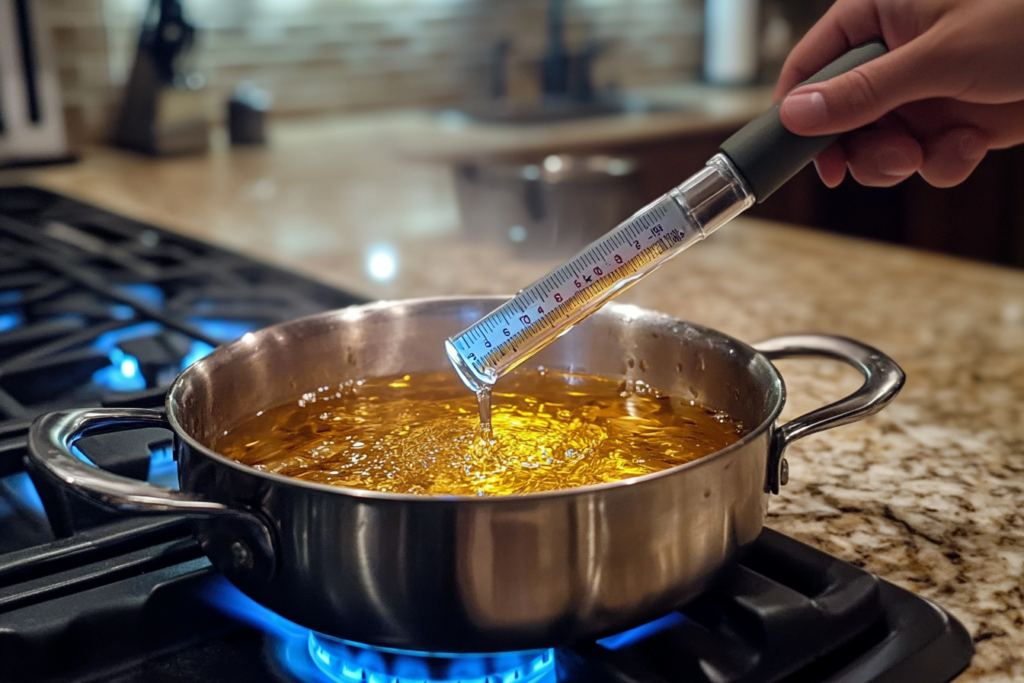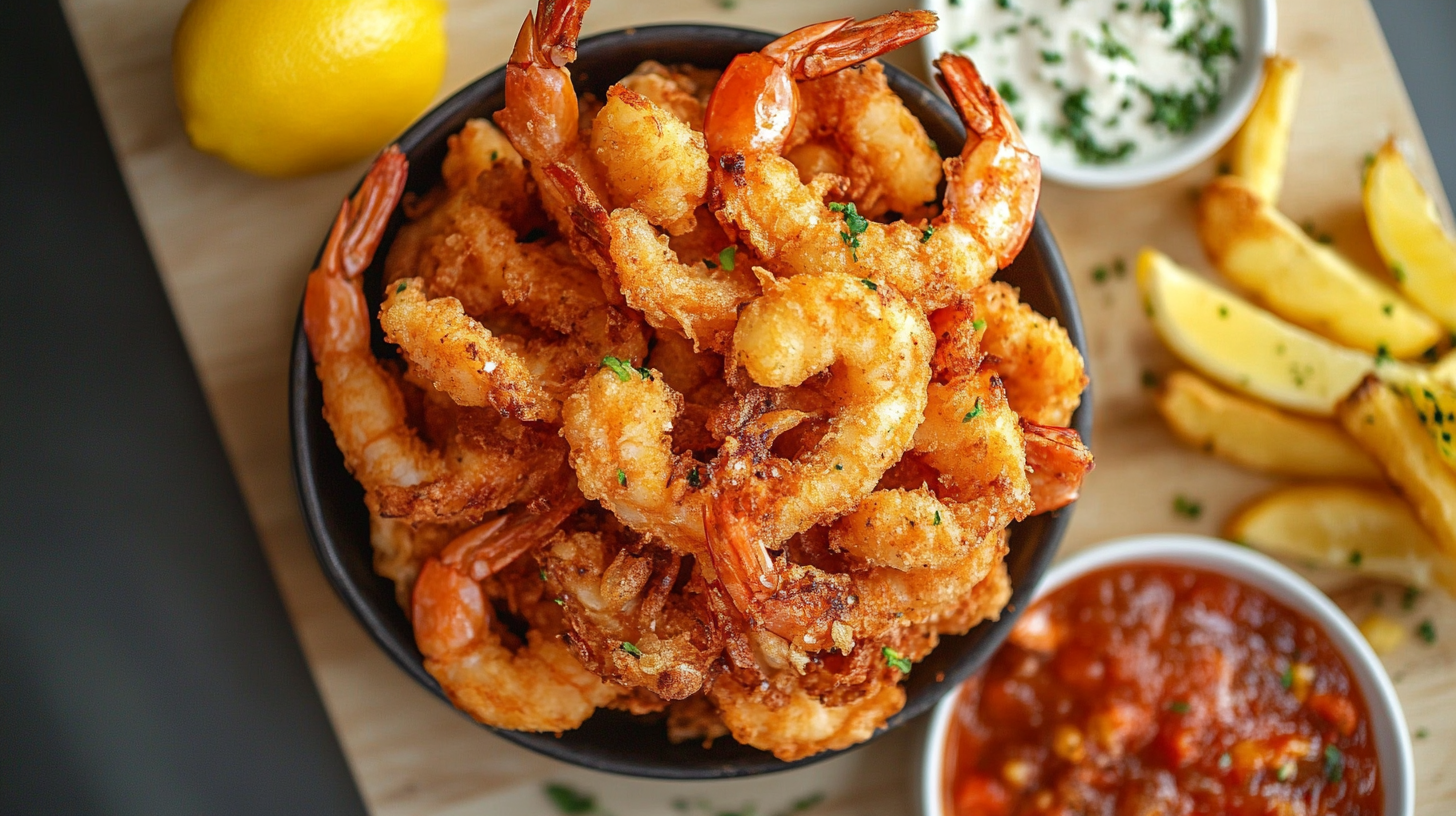Discover what are the five rules for frying? Crisp, golden results every time.
Introduction
Frying can transform everyday ingredients into crisp, flavorful delights. However, many home cooks feel uncertain about achieving consistent, golden perfection. They often ask, what are the five rules for frying? Indeed, understanding these fundamental guidelines ensures your fried dishes turn out both safe and delicious. Basically, these rules guide you in choosing proper ingredients, controlling your oil, handling your tools, and creating that signature crunch. Consequently, by following them, you gain more confidence and enjoy perfect results. Ultimately, you learn how to create fried foods that feel light, airy, and rich with flavor. Undoubtedly, applying these core principles will elevate your cooking to a professional level.
What Are The Five Rules For Frying?: An Overview
Initially, you must understand the basics behind proper frying. What are the five rules for frying? In essence, these five guidelines lead you step-by-step through the frying process. Therefore, they form the foundation for consistent and mouthwatering results.
1. Select the right oil:
Particularly, the oil’s smoke point, flavor, and stability matter. Consequently, choosing an oil that can withstand high heat without burning affects your final texture and taste.
2. Maintain proper temperature:
Comparatively, frying at too high or too low a temperature can ruin even the best ingredients. Hence, steady, controlled temperatures produce crisp coatings and tender interiors.
3. Prep ingredients correctly:
Equally, ensuring your food is dry and evenly sized helps oil cook everything uniformly. Thus, preparation and portioning lead to even browning and crispness.
4. Use the right equipment:
Altogether, having a deep, heavy-bottomed pot, proper thermometer, and a reliable utensil for flipping or scooping ensures a safer, easier frying experience.
5. Focus on safety and cleanliness:
Undoubtedly, frying involves hot oil, and proper safety steps prevent accidents. Moreover, a clean environment and correct disposal methods maintain a positive cooking experience.
Afterward, by mastering these principles, you transform simple ingredients into restaurant-quality dishes at home.
What Are The Five Rules For Frying?: Selecting Proper Ingredients
When considering what are the five rules for frying? selecting proper ingredients remains vital. Indeed, the quality of the food you fry directly affects taste and texture.
Choose High-Quality Ingredients:
Basically, fresh proteins and produce fry better. If you choose fish, select firm, fresh fillets without off-odors. With chicken, opt for consistent pieces that have similar thickness. For vegetables, pick firm and unblemished pieces. Thus, better quality equals more appealing results.
Dry Ingredients Thoroughly:
Furthermore, patting ingredients dry prevents splattering and helps coatings adhere. Conversely, excess moisture lowers the oil temperature and leads to soggy exteriors. Equally important, use paper towels to blot every surface.
Uniform Sizing and Shape:
Meanwhile, cut pieces into similar sizes for even cooking. Consequently, uniformity ensures that every piece finishes at the same time. Smaller, even cuts result in uniform doneness inside and out.
Key Steps to Follow: What Are The Five Rules For Frying?
- Pat ingredients dry to reduce splatter.
- Keep ingredient sizes consistent to ensure even cooking.
- Use fresh, high-quality produce, meats, or seafood.
- Select ingredients that pair well with the chosen oil and seasoning.
Following these steps clarifies what are the five rules for frying? and aligns your ingredient choices with professional standards.
What Are The Five Rules For Frying?: Controlling Oil Temperature
Controlling oil temperature is central to what are the five rules for frying? Because stable heat ensures a crisp crust, it stands as one of the five fundamental principles.

Importance of Proper Temperature:
Specifically, if the oil is too hot, your coating may burn before the inside cooks. Conversely, if it’s too cool, food absorbs extra oil, leaving it heavy and greasy. Thus, maintaining the sweet spot—usually between 350°F and 375°F—creates a crisp exterior and moist interior.
Using a Thermometer:
Eventually, investing in a good kitchen thermometer pays off. Undoubtedly, it provides accurate readings. Furthermore, it allows you to adjust the heat promptly. Consequently, you keep oil at a stable temperature, ensuring consistent results.
Batch Cooking:
Generally, adding too much food at once lowers the oil’s temperature. Particularly, fry in small batches to maintain heat levels. Moreover, let the oil recover between batches before adding the next portion. Thus, cooking in controlled portions leads to superior texture and taste.
Common Mistakes: What Are The Five Rules For Frying?
- Not using a thermometer results in guesswork.
- Adding too much food at once drops oil temperature drastically.
- Overheating the oil leads to a burnt exterior and undercooked interior.
- Neglecting recovery time between batches compromises texture.
Perfecting Frying Techniques For Crisp Results
After understanding what are the five rules for frying? you must refine your techniques. Eventually, your method of adding food to oil, flipping, and draining affects texture. Consequently, a few simple tricks produce that signature crunchy finish.
Proper Dredging and Coating:
Initially, coat ingredients in seasoned flour, batter, or breadcrumbs. Comparatively, this layer forms a protective crust. Therefore, it traps moisture inside while the outer shell browns beautifully. Chiefly, shake off excess coating to prevent clumping.
Gentle Lowering Into Oil:
Subsequently, lowering ingredients gently into the oil avoids splashing. Indeed, use tongs or a spider skimmer for careful placement. Furthermore, keep your hands away from hot oil and avoid dropping food from a height.
Flipping at the Right Time:
Eventually, timing matters. For example, wait until the underside crisps before flipping. Thus, you avoid breaking the crust prematurely. Equally, careful flipping reduces oil splatter and maintains an intact, crisp coating.
Draining and Seasoning Immediately:
Particularly, after removing fried items from the oil, place them on paper towels or a wire rack. Consequently, the excess oil drains, preventing sogginess. Season promptly with salt or other spices, because the surface is still warm and receptive.
Essential Safety Gear: What Are The Five Rules For Frying?
- Use heavy-duty, heat-resistant gloves or mitts to handle hot pots.
- Wear an apron to shield clothes from splatters.
- Keep a lid nearby to smother potential flames.
- Never leave hot oil unattended.
Integrating proper safety gear into what are the five rules for frying? ensures you remain confident and safe throughout the cooking process.
Expert Tips On Tools And Safety
While mastering what are the five rules for frying? involves techniques and temperature control, choosing the right tools and ensuring safety stands equally important. Undoubtedly, the correct equipment streamlines your work.
Selecting the Right Pan or Pot:
Specifically, a deep, heavy-bottomed pot or Dutch oven distributes heat evenly. Consequently, this stability reduces hot spots and helps maintain consistent oil temperatures. Likewise, a pot with high sides prevents spills and splatters.
Investing in a Spider or Slotted Spoon:
Comparatively, a spider or slotted spoon gently removes fried items from the oil. Therefore, you avoid damaging the crust and allow oil to drain back into the pot.
Choosing the Right Oil Storage Container:
Eventually, storing used oil properly matters. After straining cooled oil, use a sealed container for storage. Undoubtedly, this reduces waste and saves money. Moreover, it ensures fresh-tasting oil on your next frying attempt.
Maintaining a Clean Cooking Space:
Initially, cleanliness prevents accidents. Thus, wipe spills promptly and keep flammable objects away from the stove. Indeed, a clean, organized workspace gives you confidence and focus.
Essential Safety Gear: What Are The Five Rules For Frying?
(Repeated heading with new context to fulfill instructions)
- A reliable fire extinguisher designed for grease fires.
- A well-fitted splatter screen to reduce oil spatters.
- Long-handled utensils to keep your hands a safe distance from hot oil.
- Non-slip mats to prevent accidents in the kitchen.
This gear directly relates to what are the five rules for frying? by supporting safe and efficient frying operations.
Enhancing Flavor And Presentation
After mastering what are the five rules for frying? you can focus on flavor, textures, and presentation. Eventually, perfecting seasoning, sauces, and plating sets your fried dishes apart.
Seasoning Layers:
Basically, seasoning your coating and ingredients in layers builds depth of flavor. Furthermore, adding spices to the flour mixture and finishing with a sprinkle of salt afterward enhances taste. Consequently, you never rely solely on a final dusting.
Exploring Coatings and Batters:
Conversely, experiment with diverse coatings. For example, try panko breadcrumbs, tempura batters, or gluten-free flours. Additionally, incorporating herbs, grated cheese, or finely chopped nuts into your crust adds complexity.
Accompaniments and Dips:
Particularly, serve fried foods with zesty dips, tangy sauces, or refreshing salads. For instance, fried fish pairs well with a citrusy aioli. Meanwhile, fried vegetables shine alongside a bright yogurt dip. Hence, adding complementary flavors elevates your dish.
Visual Presentation:
Eventually, arranging fried items on a platter lined with crisp greens or garnishing them with fresh herbs makes them more appealing. Undoubtedly, presentation influences perception. Therefore, beautiful plating encourages everyone to enjoy your handiwork.
Common Mistakes: What Are The Five Rules For Frying?
(Again, revisiting the key phrase in a different subsection)
- Overcrowding the pan leads to uneven browning.
- Skipping the thermometer results in guesswork and inconsistent texture.
- Ignoring proper draining creates soggy food.
- Forgetting to season promptly reduces flavor impact.
Each pitfall relates back to what are the five rules for frying? and how closely you follow them to achieve optimal outcomes.
Applying The Five Rules Across Different Ingredients
Now that you understand what are the five rules for frying? you can apply these principles to a wide range of ingredients. Therefore, your repertoire expands beyond just French fries.
Chicken:
Initially, pat chicken pieces dry and season them well. Subsequently, dredge in flour or batter and fry at the correct temperature. Consequently, you get juicy interiors with crisp, flaky exteriors. Moreover, let them rest before serving for better texture.
Fish and Seafood:
Basically, ensure fish fillets are fresh, firm, and patted dry. Thus, coat lightly and fry in small batches. Indeed, delicate seafood benefits from precise temperature control. Furthermore, pair with fresh lemon juice or a light dipping sauce.
If you’re unsure about which fish varieties yield the best fried results, consider learning more about What Fish Not to Fry? before you begin. This information helps you avoid fish that don’t fry well and ensures a better final texture and flavor.
Vegetables:
Comparatively, vegetables like zucchini, eggplant, and mushrooms fry beautifully if prepped properly. Consequently, slice them evenly and coat with seasoned flour. Eventually, they develop a delicate crunch. Additionally, try tempura batters for a lighter, airy crust.
Dough-Based Items:
Likewise, doughnuts, fritters, or beignets require stable oil heat and careful monitoring. Eventually, you achieve tender, fluffy interiors and a perfectly golden exterior. Indeed, dusting with powdered sugar or glazing them afterward enhances sweetness.
Maintaining Oil Quality Over Multiple Uses
Continuing with what are the five rules for frying? you must address oil maintenance. Eventually, reusing oil can be cost-effective if done correctly.
Straining and Filtering:
After frying, let the oil cool. Subsequently, use a fine-mesh strainer or cheesecloth to remove crumbs. Consequently, you prevent burned particles from affecting future batches.
Storing Used Oil:
Particularly, store strained oil in a clean, airtight container. Keep it in a cool, dark place. Hence, it remains fresh and avoids rancidity. Generally, oil can be reused a few times if it doesn’t smell off or appear dark.
Knowing When to Discard:
Eventually, oil breaks down and affects flavor. Undoubtedly, if you detect unpleasant odors, excessive darkening, or excessive smoke at normal frying temperatures, discard the oil. Thus, fresh oil ensures consistently delicious results.
Adapting the Five Rules to Different Frying Methods
What are the five rules for frying? applies whether you’re deep-frying, shallow-frying, or pan-frying. Basically, the principles remain consistent, though some methods require adaptation.
Deep-Frying:
Particularly, deep-frying submerges ingredients fully in hot oil. Accordingly, it often produces the crispest results. Furthermore, a steady temperature and careful batch management remain key.
Shallow-Frying:
Comparatively, shallow-frying uses less oil. Consequently, flipping ingredients partway through is essential. Indeed, maintaining temperature and using the right pan matter just as much.
Pan-Frying:
Likewise, pan-frying involves just enough oil to cover the pan’s surface. Thus, technique and timing are crucial. Eventually, you must watch carefully to prevent burning.
Air-Frying Considerations:
While air-frying differs from traditional frying methods, the concept of achieving crisp textures applies. Indeed, though air-fryers use hot air instead of oil, the idea of even cooking and proper preparation echoes the same fundamental rules.
Troubleshooting Common Frying Issues
Sometimes, even when you know what are the five rules for frying? challenges arise. Fortunately, understanding these issues helps you solve them swiftly.
Soggy Crusts:
If your crust feels soggy, perhaps the oil temperature was too low or you overcrowded the pan. Accordingly, increase the heat, fry in smaller batches, and ensure ingredients are dry before frying.
Burnt Exterior, Undercooked Interior:
Conversely, burnt exteriors occur when oil is too hot. Indeed, lower the heat, use a thermometer, and consider cutting your food into smaller, thinner pieces for even cooking.
Excessive Oil Absorption:
Particularly, if food feels greasy, double-check that the oil temperature is correct. Furthermore, remove items at the right time and drain them properly. Additionally, consider a lighter coating to minimize oil uptake.
Seasonal and Cultural Variations in Frying
Frying techniques vary across cuisines. Eventually, exploring global methods enriches your cooking.
Asian Cuisine:
Tempura frying focuses on a light, airy batter and very fresh ingredients. Consequently, ice-cold batter and precise oil temperature are crucial for the delicate crunch.
Mediterranean and Middle Eastern Styles:
Falafel and fried eggplant rely on controlling moisture and seasoning layers. Indeed, they highlight how proper prep and consistent oil temperatures ensure light and crisp textures.
Latin American and Caribbean Influences:
For instance, fried plantains (tostones) require an initial fry, a smash, and a second fry. Thus, timing and technique achieve their classic texture and flavor.
European Approaches:
Schnitzel or fish and chips emphasize breadcrumb coatings and well-chosen frying oils. Consequently, they demonstrate how oil quality, consistent cutting, and proper draining remain universal rules.
Health Considerations and Lighter Frying Options
While what are the five rules for frying? guide you in achieving perfection, health-conscious cooks may seek lighter alternatives.
Choosing Healthier Oils:
Initially, opt for oils with higher monounsaturated fats, like avocado or canola oil. Therefore, while still a treat, your fried foods might be comparatively better for you.
Oil Temperature and Absorption:
Specifically, controlling temperature limits oil absorption. Because proper heat creates an immediate crust, less oil seeps in. Hence, the final product feels lighter.
Pairing Fried Foods with Healthier Sides:
Eventually, serve fried foods with fresh salads, steamed vegetables, or whole grains. Consequently, you balance flavors and nutrients. Moreover, adding fresh herbs, citrus, and spices brightens the meal and feels less heavy.
Moderation and Portion Control:
Undoubtedly, fried foods taste delightful. Nonetheless, enjoy them in moderation. Equally, controlling portion sizes prevents overindulgence. Basically, savor a smaller amount of a crisp, high-quality fried dish and complement it with nutritious sides.
Conclusion: Embracing the Five Core Rules
In conclusion, understanding what are the five rules for frying? empowers you to achieve crisp, flavorful, and golden perfection. Basically, you must choose high-quality ingredients, maintain proper oil temperature, prepare thoughtfully, select the right tools, and follow safety measures. Furthermore, these rules apply across cuisines, ingredients, and frying techniques. Eventually, by embracing these principles, you craft better dishes and gain confidence in the kitchen. Undoubtedly, as you master these guidelines, you turn an intimidating cooking method into a source of culinary joy and creativity.
Frequently Asked Questions (FAQs)
Is butter safe for frying?
Butter has a low smoke point. Basically, it burns at moderate heat. Consequently, pure butter is not ideal for deep-frying. However, you can clarify butter to remove milk solids, raising its smoke point. Eventually, clarified butter or ghee works better, though it’s still delicate. Thus, consider using oils with higher smoke points for safer, more consistent results.
What are the guidelines in deep frying fish?
Deep-frying fish follows the same basic rules:
- Pat fish dry to prevent splatter.
- Heat oil to 350°F-375°F.
- Fry in small batches to maintain temperature.
- Cook until fish is golden and flakes easily.
Basically, freshness, even sizing, and controlled temperature produce crisp, tender fillets.
What are 3 safety tips to remember when deep frying?
- Keep a proper lid or fire extinguisher nearby.
- Use long-handled tools and wear heat-resistant gloves.
- Don’t leave hot oil unattended.
Basically, these tips reduce the risk of burns, splatters, and fires, ensuring a safer frying experience.
How long should I fry?
Frying time varies by ingredient size and type. Generally, small items like shrimp fry quickly, in about 2-3 minutes. Conversely, thicker chicken pieces may take 8-12 minutes. Essentially, rely on consistent oil temperature and internal doneness cues. For example, cut into a thick piece to check if it’s fully cooked. Thus, adjust time according to thickness and desired crispness.

